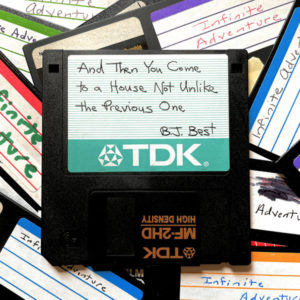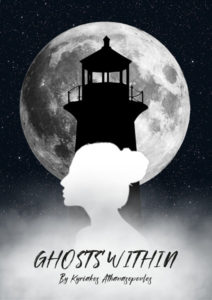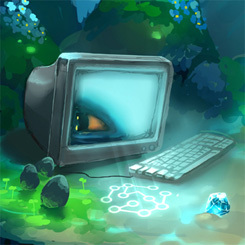See here for my IFComp 2021 scoring and reviewing rubrics.
The Song of the Mockingbird by Mike Carletta is an Old West tale with a heart of gold and a country-style sense of humor. You are a singing cowboy known as the Texas Mockingbird, although you prefer folks called you “Boots” Taylor. Your sweetie has been kidnapped by the Black Blade and his gang of outlaws. Black Blade also saw fit to relieve you of your sidearm, so it’s only you, your wits, and your guitar (nicknamed “Lulabelle”).
“Boots” is a character unto himself. He’s liable to break out in song if you give him half a chance. Playing his guitar rewards the player with a nickel jukebox worth of country-western lyrics, which “Boots” is capable of warbling in even the tensest of moments.
The game starts in the thick of things, with Boots pinned down by gunfire. His lack of a sidearm means your options are dashing about, staying out of lines of sight, and attempting to eliminate the gang by more indirect means. The dialogue between Boots and the outlaws adds nice dashes here and there. The game never goes blue or resorts to cruelty, at least within my two hours of play. It’s a clean-shaven game.
The prose is exceedingly well done, understated in a way that great Western prose is:
Thunder’s powerful muscles move steadily under you as you gallop down the arroyo toward the showdown with the Black Blade. You don’t know what you’ll do without your trusty revolver, but you trust that fate will provide. Rosa’s life depends on it.
And like all good Westerns, the author adds a couple of “end of an era” touches, such as the post-Civil War worthlessness of Confederate money, or how the dreaded “Devil’s Rope” cordoned off America’s Great Plains:
They call it “barbed wire.” The spikes keep the cattle from leaning on the fence and bustin’ through. You shake your head sadly. This land was meant to be open for all. The Devil’s Rope means the end of the open range.
Mockingbird self-declares as Merciful on the Zarfian scale, and the game is indeed merciful as you work through the puzzles. They’re interwoven well and always organic to Boots’ situation. Generally, solving them merely requires thinking how a cowpoke would think under such tight circumstances. I did get stuck a few times. The robust HINT system helped me out of most of the jams. I was so engrossed by Boots’ predicament, I had trouble setting the game aside. The only bugs I found related to a barrel’s hoops, of all things.
What other problems did I have? Few, to be honest. One light criticism I would make regards the title. As a game which falls squarely within the Western genre, its spirit lands closer to The Ballad of Buster Scraggs than The Good, the Bad, and the Ugly, but the current title doesn’t capture either tone. It’s a minor nitpick; I’m putting it out there.
Another problem is more serious: When I mentioned the game starts with Boots pinned down by gunfire, well, the rest of the game is more of him being pinned down. The puzzles keep things fresh, but I grew to wonder if there were any other dimensions to this otherwise polished package. Perhaps if I had more time to play.
The Song of the Mockingbird is an enmeshing parser game with a sense of drama as well as a sense of humor. It avoids the corn pone and the usual tropes of the Western genre. I’m sold.




